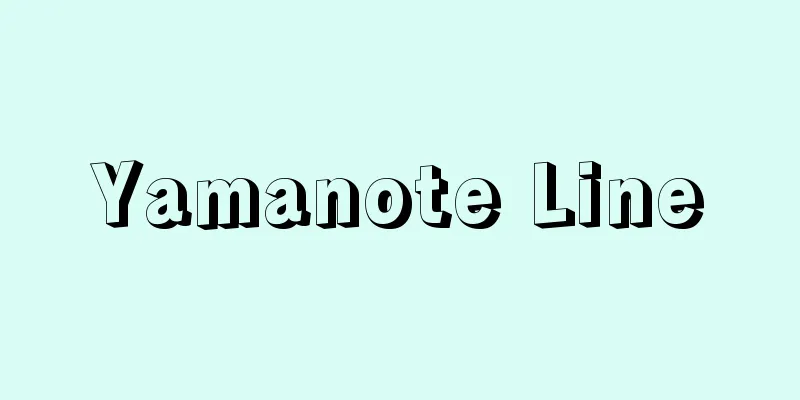Yamanote Line

|
The name of the track of East Japan Railway Company (JR East Japan). Tokyo, Shinagawa-Shinjuku-Tabata, 20.6 km. The entire line is quadruple track (two sets of double tracks laid), DC electrified. The first section was Shinagawa-Akabane, opened in 1885 (Meiji 18) by Japanese Railways (current Tohoku Main Line, Takasaki Line, etc.) as a connecting line with the government railway (later the Tokaido Main Line), and the Ikebukuro-Tabata section was opened in 1903 (Meiji 36). In 1906, Japanese Railways was nationalized, and the above lines were combined to form the Yamanote Line in 1909 when the track names were established. As the urban area of Tokyo expanded, the demand for passenger transport also increased, and in 1909, the Karasumori (current Shimbashi)-Shinagawa-Ikebukuro-Tabata-Ueno section and the Ikebukuro-Akabane section were electrified and electric trains began operating. In 1925 (Taisho 14), with the opening of the Ueno-Tokyo section, the Tokaido Main Line and the Tohoku Main Line were directly connected, and a circular train service was established between central Tokyo and the west side of the city via the Yamanote Line, and the Yamanote Line became the name of the line section as well as the term for the Tokyo circular train service. The Yamanote Line as a line section was built on a route that passed just outside the administrative district of the Tokyo wards (later Tokyo City) at the time, and therefore became the de facto boundary between the city-run streetcar network and the private suburban railway network. Since the 1920s, with the development of residential areas in the western suburbs of Tokyo, terminal stations for suburban trains were built on the Yamanote Line, and the surrounding area grew into a central area known as the sub-center. The line also gradually developed into a freight line connecting the main railways concentrated in Tokyo, and in 1925, passenger trains and freight trains were separated from each other when the four-track line was completed between Shinagawa, Ikebukuro, and Tabata (Yamate Freight Line). However, with the opening of the Musashino Line as the Tokyo Outer Circular Route (1973), the function of the Yamanote Freight Line was reduced, and in 1985, trains commonly known as the Saikyo Line (Kawagoe-Omiya-Akabane-Shinjuku, later extended to Osaki) began using the old freight line between Ikebukuro and Shinjuku. In 1972, the Akabane-Ikebukuro section (5.5 km) was separated into the Akabane Line, and only the current section became the Yamanote Line. For a time, the name of the line was pronounced "Yamate" and "Yamanote", but the previous year it was changed to "Yamanote". In 1987, following the privatization of the Japanese National Railways (JNR), it became part of East Japan Railway Company. It has the highest passenger traffic density of all JR lines in Japan, and is also known as a highly profitable line. [Eiichi Aoki and Ryo Aoki, November 13, 2020] Source: Shogakukan Encyclopedia Nipponica About Encyclopedia Nipponica Information | Legend |
|
東日本旅客鉄道(JR東日本)の線路名称。東京都、品川―新宿―田端(たばた)間、20.6キロメートル。全線複々線(複線軌道を2組敷設)、直流電化。日本鉄道(現在の東北本線、高崎線など)が官設鉄道(後の東海道本線)との連絡線として1885年(明治18)に開業した品川―赤羽(あかばね)間が最初の形態で、1903年(明治36)池袋―田端間が開業した。1906年日本鉄道は国有化され、1909年の線路名称の制定とともに前記の路線をあわせて山手線となった。東京の市街地の拡大とともに旅客輸送需要も増大し、1909年、烏森(からすもり)(現、新橋)―品川―池袋―田端―上野間と池袋―赤羽間が電化されて電車運転を開始した。1925年(大正14)には上野―東京間の開業とともに東海道本線と東北本線が直接結ばれて、山手線を介して東京都心部と市街地西側を経由する環状運転が行われるようになり、山手線は線区の名称であるとともに東京の環状運転電車を意味する語ともなった。線区としての山手線は当時の東京区部(後の東京市)の行政区域のすぐ外側を通過するルートで建設されたため、市営の市街電車網と民営の郊外鉄道網の事実上の境界線となり、1920年代以降、東京西郊住宅地域の発展とともに、郊外電車のターミナル駅が山手線上に立地して、その周辺は副都心とよばれる中心地に成長した。また東京に集中する幹線鉄道を相互に結ぶ貨物連絡線としての機能もしだいに発達して、1925年に品川―池袋―田端間の複々線全通とともに旅客列車と貨物列車の分離が行われた(山手貨物線)。しかし、東京外環状線としての武蔵野(むさしの)線の開業(1973)によって、山手貨物線の機能は縮小され、1985年(昭和60)から通称埼京(さいきょう)線の電車(川越(かわごえ)―大宮―赤羽―新宿間、のち大崎まで延伸)が池袋―新宿間で旧貨物線を利用するようになった。また、1972年に赤羽―池袋間(5.5キロメートル)は赤羽線として独立し、現在の区間のみが山手線となった。なお線名の読み方は、一時期「やまて」と「やまのて」が混在していたが、前年に「やまのて」と改められた。1987年、日本国有鉄道(国鉄)の分割民営化に伴い、東日本旅客鉄道に所属。全国のJR線のなかで旅客運輸密度がもっとも高く、高収益率の線区としても知られる。 [青木栄一・青木 亮 2020年11月13日] 出典 小学館 日本大百科全書(ニッポニカ)日本大百科全書(ニッポニカ)について 情報 | 凡例 |
>>: Mina Yamauchi - Mina Yamauchi
Recommend
Rainwater - Amatsumizu
[1] [noun] Heavenly water. Sacred water that is sa...
The Greyhound Corp.
A holding company that includes the largest bus co...
Volcanic Physics
...We also analyze the propagation of seismic wav...
Jenner - Edward Jenner
British doctor. Born in Berkeley as the third son...
Character display - Mojihyojisouchi (English spelling) character display
A type of computer output device. Also known as a ...
Akarnania (English spelling)
A backward region in northwestern ancient Greece. ...
Karukayainko (English spelling) grey-headed lovebird
A bird of the order Psittacidae in the class Aves...
Kappo - Kappo
...It is used by young girls in formal attire and...
Ann Landers - Ann Landers
...Her real name is Esther Pauline Friedman Leder...
Flowering tree - Kaboku
It refers to trees that have beautiful flowers wo...
Krupp AG
A German heavy industry company. It began in 1811 ...
Example name - Reimyo
A term used in the land system to indicate a unit ...
Turner, JJ
...Kr・5.76H 2 O (decomposition pressure 14.5 atm ...
Baltic Sea
…Königsberg was formerly known as Königsberg. It ...
Globule - globule
A type of dark nebula. The space between stars is...

![Shiota [town] - Shiota](/upload/images/67cbbb0892d70.webp)







